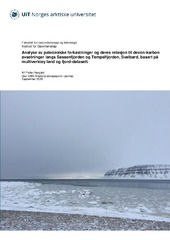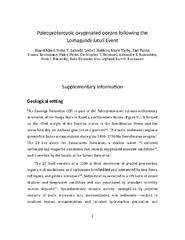Institutt for geovitenskap: Recent submissions
Now showing items 481-500 of 1121
-
The role of oxides in the shallow vesiculation of ascending magmas
(Journal article; Tidsskriftartikkel; Peer reviewed, 2020-10-01)Despite their generally low volume fraction, Fesingle bondTi oxides have the potential to greatly influence the eruptive style because they lower the supersaturation pressure for heterogeneous bubble nucleation. Once nucleated, bubbles respond fast to pressure changes, fostering rapid expansion and explosive behavior. Yet, oxide microlite quantifications are often absent from data of explosive ... -
Impact of tides and sea-level on deep-sea Arctic methane emissions
(Journal article; Tidsskriftartikkel; Peer reviewed, 2020-10-09)Sub-sea Arctic methane and gas hydrate reservoirs are expected to be severely impacted by ocean temperature increase and sea-level rise. Our understanding of the gas emission phenomenon in the Arctic is however partial, especially in deep environments where the access is difficult and hydro-acoustic surveys are sporadic. Here, we report on the first continuous pore-pressure and temperature measurements ... -
Shallow Gas Hydrate Accumulations at a Nigerian Deepwater Pockmark—Quantities and Dynamics
(Journal article; Tidsskriftartikkel; Peer reviewed, 2020-08-06)The evolution of submarine pockmarks is often related to the ascent of fluid from the subsurface. For pockmarks located within the gas hydrate stability zone, methane oversaturation can result in the formation of gas hydrates in the sediment. An ~600 m‐wide sea floor depression in deep waters offshore Nigeria, Pockmark A, was investigated for distributions and quantities of shallow gas hydrates, ... -
Food/feed and environmental risk assessment of genetically modified glufosinate-tolerant oilseed rape MS8, RF3 and MS8 x RF3 for import, processing and feed uses under Directive 2001/18/EC (Notification C/BE/96/01)
(Research report; Forskningsrapport, 2014-03-28)In preparation for a legal implementation of EU-regulation 1829/2003, the Norwegian Environment Agency (former Norwegian Directorate for Nature Management) has requested the Norwegian Food Safety Authority (NFSA) to give final opinions on all genetically modified organisms (GMOs) and products containing or consisting of GMOs that are authorized in the European Union ... -
Analyse av paleozoiske forkastninger og deres relasjon til devon-karbon avsetninger langs Sassenfjorden og Tempelfjorden, Svalbard, basert på multiverktøy land og fjord-datasett.
(Master thesis; Mastergradsoppgave, 2020-09-02)Ledd i Billefjordforkastningssonen kan man finne på begge sidene av Sassenfjorden. Disse leddene er forsøkt knyttet sammen i denne analysen. Batymetriske data fra Sassenfjordens fjordbunn avslører rygger og andre strukturer som har en spennende innvirkning på de seismiske dataene. Hovedfunnene i denne analysen er kategorisert i tre kategorier. Kategori 1 omtaler en obskur sone på seismikken som ... -
Foreløpig helse- og miljørisikovurdering av genmodifisert maislinje Event 5307 fra Syngenta Crop Protection AG (EFSA/GMO/DE/2011/95)
(Research report; Forskningsrapport, 2011-11-25)Den foreløpige helse- og miljørisikovurderingen av insektresistent maislinje 5307 (EFSA/GMO/DE/2011/95) fra Syngenta Crop Protection AG er utført av Faggruppe for genmodifiserte organismer i Vitenskapskomiteen for mattrygghet (VKM). Vitenskapskomiteen for mattrygghet er bedt av Mattilsynet og Direktoratet for naturforvalting ... -
Does Arctic warming reduce preservation of organic matter in Barents Sea sediments?
(Journal article; Tidsskriftartikkel; Peer reviewed, 2020-08-31)Over the last few decades, the Barents Sea experienced substantial warming, an expansion of relatively warm Atlantic water and a reduction in sea ice cover. This environmental change forces the entire Barents Sea ecosystem to adapt and restructure and therefore changes in pelagic–benthic coupling, organic matter sedimentation and long-term carbon sequestration are expected. Here we combine new and ... -
Quartz textural analysis from an anastomosing shear zone system: Implications for the tectonic evolution of the Ribeira belt, Brazil
(Journal article; Tidsskriftartikkel; Peer reviewed, 2020-07-18)Strain localization and influence of grain-size reduction processes were investigated from field and microstructural observations, and from quartz textural analysis using EBSD, in rocks deformed along an anastomosing network of shear zones in the Ribeira belt in Brazil. Rocks deformed along the Lancinha shear zone (LSZ) display high percentage of recrystallized grains, in which quartz recrystallized ... -
Transformation weakening: Diffusion creep in eclogites as a result of interaction of mineral reactions and deformation
(Journal article; Tidsskriftartikkel; Peer reviewed, 2020-07-09)The deformation of eclogites and the driving forces for their fabric development are an important topic, potentially allowing to determine deformation rates and stresses in subduction zones, where the greatest number of large earthquakes occurs. Here, fabric studies of grain size and shape, texture, and chemical composition from two locations of Variscan and Alpine eclogites are presented. All samples ... -
Oxygenated conditions in the aftermath of the Lomagundi-Jatuli Event: The carbon isotope and rare earth element signatures of the Paleoproterozoic Zaonega Formation, Russia
(Journal article; Tidsskriftartikkel; Peer reviewed, 2020-07-09)The c. 2.0 Ga Zaonega Formation of the Onega Basin (NW Russia) has been central in efforts to understand what led to the initial rise (Great Oxidation Event, GOE) and postulated fall in free atmospheric oxygen and associated high-amplitude carbon cycle excursions, the Lomagundi-Jatuli Event (LJE) and subsequent Shunga Event during Paleoproterozoic time. The Formation accumulated shortly after the ... -
Amorphous material in experimentally deformed mafic rock and its temperature dependence: Implications for fault rheology during aseismic creep and seismic rupture
(Journal article; Tidsskriftartikkel; Peer reviewed, 2020-05-20)Amorphous materials are frequently observed in natural and experimentally produced fault rocks. Their common occurrence suggests that amorphous materials are of importance to fault zone dynamics. However, little is known about the physico-chemical impact of amorphous materials on fault rheology. Here we present deformation experiments on mafic fault rock, where amorphous material forms due to intense ... -
Fast and slow components of interstadial warming in the North Atlantic during the last glacial
(Journal article; Tidsskriftartikkel; Peer reviewed, 2020-08-13)The abrupt nature of warming events recorded in Greenland ice-cores during the last glacial has generated much debate over their underlying mechanisms. Here, we present joint marine and terrestrial analyses from the Portuguese Margin, showing a succession of cold stadials and warm interstadials over the interval 35–57 ka. Heinrich stadials 4 and 5 contain considerable structure, with a short ... -
REE+Y uptake and diagenesis in Recent sedimentary apatites
(Journal article; Tidsskriftartikkel; Peer reviewed, 2019-07-30)Rare Earth Elements and Yttrium (REE+Y) distribution in authigenic phases are frequently used as proxies for reconstructing past seawater conditions. Sedimentary apatite precipitates near the sediment-water interface and is therefore capable of recording the REE+Y composition of the overlying water column. While the overprinting of primary REE+Y signal during late stage diagenesis is a widely known ... -
Palaeoproterozoic oxygenated oceans following the Lomagundi–Jatuli Event
(Journal article; Tidsskriftartikkel; Peer reviewed, 2020-03-16)The approximately 2,220–2,060 million years old Lomagundi–Jatuli Event was the longest positive carbon isotope excursion in Earth history and is traditionally interpreted to reflect an increased organic carbon burial and a transient rise in atmospheric O<sub>2</sub>. However, it is widely held that O<sub>2</sub> levels collapsed for more than a billion years after this. Here we show that black shales ... -
Past ice sheet-seabed interactions in the northeastern Weddell Sea embayment, Antarctica
(Journal article; Tidsskriftartikkel; Peer reviewed, 2020-06-30)The Antarctic ice sheet extent in the Weddell Sea embayment (WSE) during the Last Glacial Maximum (LGM; ca. 19–25 calibrated kiloyears before present, ka cal BP) and its subsequent retreat from the shelf are poorly constrained, with two conflicting scenarios being discussed. Today, the modern Brunt Ice Shelf, the last remaining ice shelf in the northeastern WSE, is only pinned at a single location ... -
Hydrothermal dedolomitisation of carbonate rocks of the Paleoproterozoic Zaonega Formation, NW Russia — Implications for the preservation of primary C isotope signals
(Journal article; Tidsskriftartikkel; Peer reviewed, 2019-03-03)The Paleoproterozoic Zaonega Formation in Karelia, NW Russia, has played a key role in understanding the environmental conditions postdating the Great Oxidation and Lomagundi-Jatuli Events. Its carbonate- and organic-rich rocks (shungite) define the postulated Shunga Event representing an accumulation of very organic-rich sediments at c. 2 Ga and are central in ideas about changing ocean-atmosphere ... -
The effect of an experimental decrease in salinity on the viability of the subarctic planktonic foraminifera Neogloboquadrina incompta
(Journal article; Tidsskriftartikkel; Peer reviewed, 2020-08-27)Chemical signatures in the calcite of shells of polar and subpolar planktonic foraminifera have been frequently used to trace and quantify past meltwater discharge events. This approach assumes that the foraminifera can tolerate low salinity under extended periods. To obtain a first experimental constraint on salinity tolerance of Subarctic foraminifera, we carried out a culturing experiment with ... -
The tectonized central peak of the Mjølnir Impact Crater, Barents Sea
(Journal article; Tidsskriftartikkel; Peer reviewed, 2019-12-04)The Mjølnir structure, SW Barents Sea, is one of the best-preserved marine impact craters on Earth. After impact on the paleo-seafloor about 142 Ma ago, this crater experienced an atypical deformation of its central peak, which is now elevated ~435 m above the crater rims. Here, we investigate the effect of far-field tectonic stresses on the central peak uplift based on interpretation of new ... -
Transferring grains from single-grain luminescence discs to SEM specimen stubs
(Journal article; Tidsskriftartikkel; Peer reviewed, 2019-11-21)The grain transfer protocol presents a step-by-step guide on how to successfully transfer positioned grains from a single-grain luminescence disc to a scanning electron microscope (SEM) specimen stub and how to transport them between laboratories. Single-grain luminescence analysis allows the determination of luminescence characteristics for individual sand-sized grains. By combining such luminescence ... -
Adamastor – an ocean that never existed?
(Journal article; Tidsskriftartikkel; Peer reviewed, 2020-05-08)<p>Existing models of tectonic evolution of the Neoproterozoic orogenic system rimming the shores of the South Atlantic Ocean (the Araçuaí–Ribeira–Congo and Dom Feliciano–Kaoko–Gariep belts) interpret the belts as subduction-related orogens and emphasize the role of the “Adamastor Ocean” in their pre-collisional evolution. A critical problem in such an interpretation is the confined nature of the ...


 English
English norsk
norsk


















